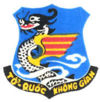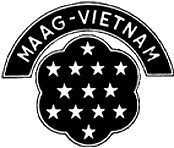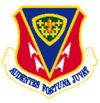 On 8 May 1965 the 20th Tactical Air Support Squadron (TASS) was activated as part of the 505th Tactical Control Group. On
8 September 1966 the unit was assigned to the 6250th Tactical Air Support Group (Provisional then on 8 December 1966 the squadron became part of the 504th Tactical Air Support Group headquartered at Tan Son Nhut Air Base near Saigon.
On 8 May 1965 the 20th Tactical Air Support Squadron (TASS) was activated as part of the 505th Tactical Control Group. On
8 September 1966 the unit was assigned to the 6250th Tactical Air Support Group (Provisional then on 8 December 1966 the squadron became part of the 504th Tactical Air Support Group headquartered at Tan Son Nhut Air Base near Saigon.
The squadron was authorized thirty "Cessna L-19 Bird Dog 0-1 Birddog aircraft, however this allocation proved difficult to fill, since the aircraft were being transferred from other agencies, primarily the Army.
Four months before its organization, the Air Force had 20 aircraft required by the TASSs in Vietnam. The TASS’s growth was dependent on and linked to the acquisition of the 0-1s from other agencies. While TASS operations were initiated in August 1965, it wasn’t until the end of the year that the 20th TASS received its full complement of aircraft.As the Forward Air Controller (FAC) pilots began to arrive, they were provided with familiarization checkouts and theater indoctrination flights. Upon completion of these requirements, FACs were assigned to support US and Vietnamese Army units. During this period, FACs were given many and varied tactical call signs.
In the latter part of 1965, the 20th TASS was assigned the out-of-country mission, which entailed flying interdiction missions over the
Hô Chi Minh Trail in. It's area of operations (AO) was designated TIGERHOUND. To meet its mission requirements it was necessary to establish a number of forward operating bases (FOB) to support the operation. Initially, FOBs were established at Khe Sanh, Kham Duc, and Kontum. Eventually, the sites were expanded to include Đà Nàng, Đông Hà Air Field, Dak To, and Pleiku.In mid-July 1966, the 20th TASS was assigned another mission and AO. The new mission was designed TALLY HO. The AO was part of the STEEL TIGER area located in North Vietnam from the Demilitarized Zone (DMZ) to about 30 miles north of the DMZ. The TALLY HO missions were flown from Đông Hà Air Field. During this period, it was decided that all out-of-country tactical call signs would carry the name of COVEY.
The 0-1, whether by design or accident proved to be an outstanding FAC aircraft. It provided exceptional visibility, was not complicated, and was surprisingly easy to fly. However, as the weapons of the Viet Cong and the North Vietnamese regulars became more sophisticated, the 0-1’s vulnerability was accentuated. This vulnerability was countered by a new FAC aircraft. The new FAC aircraft was the Cessna Skymaster which was a modified Cessna 337. It was an inline dual engine aircraft with one propeller pushing and the other pulling.
From late 1966 until late, approximately 350 0-2s were contracted for by the Air Force. The first 0-2s, to arrive in country were assigned to the 20th TASS. They were then assigned to Đông Hà Air Field and Khe Sanh to provide a more substantial FAC aircraft to deal with the improvements in the enemy’s weaponry. By reading some of the narratives submitted by 0-2 pilots, the reader will become acutely aware of the 0-2’s capabilities and limitations.The 0-2 was an interim aircraft, but it filled a void while the OV-10 Bronco was being developed.
The 0V-10 was a more sophisticated and durable FAC vehicle: it had greater ordnance carrying capability, more loiter time, a bit more power, and a greater array of conventional navigation aids and in-flight instrumentation. The 20th TASS received its first 0V-10s in July 1969. The arrival of the 0V-10s to complement the O-2As resulted in the transfer of the 0-1s to other units.By October 1969, the 20th TASS, while supporting five US Army and six South Vietnam force locations, as well as the out-of-country operations, was operating from Đà Nàng and eleven FOBs.
As the US Army began to gradually reduce its presence in and 1973, the 20th TASS began withdrawing from its FOBs.In response to the North Vietnamese spring offensive of 1972, the 20 TASS reestablished some of its former FOBs. It is notable to mention that in June 1972, the 20th TASS had tripled its pre-invasion sorties. Further, Covey FACs from Đà Nàng using 0V-10s were a vital and integral part of base defense operations during that year.In January 1973, the 20th TASS ceased operations at its last FOB, and flew its final missions in Vietnam.
The 0-2s were turned over to the Vietnamese Air Force, and the 0V-10s were assigned to other USAF units in Southeast Asia.On 25 January 1973 the 20th TASS moved, without personnel or equipment, to George AFB, California.
Other Units At Đà Nàng
The 37th Aerospace Rescue and Recovery Squadron, variously operating HU-16s, HH-3Es and HH-53s, was assigned to Đà Nàng Air Base for most of the war.
The 6th Air Commando/Special Operations Squradron based at Pleiku Air Base maintained a detachment of Douglas A-1EH "Skyraiders" at Đà Nàng from 1 April
- 1 September 1969. The unit flew combat missions, including air support for ground forces, air cover for transports, day and night interdiction, combat search and rescue support, armed reconnaissance, and forward air control.United States Marine Corps: III Marine Amphibious Force>; 1st Marine Aircraft Wing, 1st Marine Division; 7th Marine Regiment; 27th Marine Regiment;United States Navy: 3rd Naval Mobile Construction Brigade; Naval Support Activity.Known SVNAF Units At Đà Nàng (June 1974 Table Of Organization)
 Đà Nàng Air Base was the headquarters of the SVNAF 1st Air Division. 41st Tactical Wing
Đà Nàng Air Base was the headquarters of the SVNAF 1st Air Division. 41st Tactical Wing
- 110th/120th Liaison Squadron Cessna O-1A, O-2, U-17
- 427th Transport Squadron C-7B
- 718th Reconnaissance Squadron EC-47
- 821st Attack Squadron AC-119K
51st Tactical Wing
- 213th/233d/239th/253d/257th Helicopter Squadron Bell UH-1H
- 247th Helicopter Squadron CH-47A
61st Tactical Wing
- 516th/528th/550th Fighter Squadron A-37B
- 538th Fighter Squadron F-5A/B/E
Capture Of Đà Nàng Air Base
With the capture of Ban Mê Thuột and the Central Highlands by North Vietnamese forces in late
March 1975, the disastrous retreat by the ARVN had a profound effect on the South Vietnamese troops and civilians around Hue, Quang Tri, and Đà Nàng.
Conflicting orders from Saigon caused confusion, lowered morale, and led to troop movements which defied any logic. As rockets and artillery fire began to hit Đà Nàng Air Base on 28 March, the 1st Air Division was ordered to evacuate. Those ARVN soldiers who did not desert to assist their fleeing families, but instead chose to stand and fight, were overrun.
The troops who somehow managed to escape capture then joined the crazed mob attempting to leave Đà Nàng on anything that floated. Chaos ruled the streets of Đà Nàng Easter weekend 1975 as military deserters armed with their combat weapons attempted to dictate the terms of their departure. Before the weekend ended some of the most disciplined members of the armed forces would use their weapons against their countrymen in order to gain passage from Đà Nàng. Approximately 130 aircraft managed to evacuate but over 180 were left behind along with huge stocks of fuel and ordnance. Abandoned were thirty-three A-37s, most of which were captured intact by the NVA. By 30 March one of the largest cities in South Vietnam and its huge Air Field were under communist control. Coming so soon after the loss of Kontum and Pleiku, the fall of Đà Nàng caused widespread panic and desertion within the South Vietnamese armed forces.
The North Vietnamese, sensing that victory was theirs, deployed their reserves and immediately began pushing south along the coast in what was known as the Hô Chi Minh Campaign, the final push toward Saigon.





